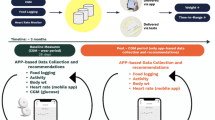Abstract
Nutrition has a big impact on health, including major diseases such as heart disease, osteoporosis, and cancer. This paper presents an application designed to help people keep track of the nutrional content of foods they have eaten. Our work uses shopping receipts to generate suggestions about healthier food items that could help to supplement missing nutrients. We present our system design: a capture and access application that, based on shopping receipt data, provides access to ambiguous suggestions for more nutritious purchases. We also report results from one formative user study suggesting that receipts may provide enough information to extend our work by also estimating what people are actually eating, as opposed to simply what they are purchasing.
Access this chapter
Tax calculation will be finalised at checkout
Purchases are for personal use only
Preview
Unable to display preview. Download preview PDF.
Similar content being viewed by others
References
G. D. Abowd and E. D. Mynatt. Charting past, present, and future research in ubiquitous computing. ACM TOCHI, 7(1):29–58, 2000.
J. L. Balintfy. Menu planning by computer. Communications of the ACM, 7(4):255–259, 1964.
J. Beidleret al. The PNA project. In Proceedings of the sixth annual CCSC northeastern conference on The journal of computing in small colleges, pp. 276–284. The Consortium for Computing in Small Colleges, 2001.
CNPP. Interactive healthy eating index. Powered by Commerce One http://147.208.9.133/.
A. K. Dey, G. D. Abowd, and D. Salber. A conceptual framework and a toolkit for supporting the rapid prototyping of context-aware applications. Human Computer Interaction, 16(2–4):97–166, 2001.
A. Eertmans, F. Baeyens, and O. V. denBergh. Food likes and their relative importance in human eating behavior: Review and preliminary suggestions for health promotion. Health Education Research, 16(4):443–456, 2001.
Food and Nutrition Information Center. Recommended daily allowances, 1989.
Food and Nutrition Information Center. Dietary reference intakes, 2001.
A. Garrison, S. J. Mountford, and G. Thomas. Designing computers with people in mind. interactions, 1(2):61–72, 1994.
S. Hankinson et al., editors. Healthy Women, Healthy Lives: A Guide to Preventing Disease. A Harvard Medical School book. Simon & Schuster Inc., 2001.
F. Hu et al. Reproducibility and validity of dietary patterns assessed with a food-frequency questionnaire. American Journal of Clinical Nutrition, 69(2):243–249, February 1999.
INSIGHT 19. Beliefs and attitudes of americans toward their diet. USDA Center for Nutrition Policy and Promotion, June 2000.
INSIGHT 20. Consumption of food group servings: People’s perceptions vs. reality. USDA Center for Nutrition Policy and Promotion, October 2000.
J. Mankoff, S. E. Hudson, and G. D. Abowd. Interaction techniques for ambiguity resolution in recognition-based interfaces. In Proceedings of the ACM UIST 2000, pp. 11–20. ACM Press, November 2000.
Nutrient Data Laboratory. Usda nutrient database for standard reference, release
Nutrient Data Laboratory Web Page http://www.nal.usda.gov/fnic/foodcomp.
K. Swearingen and R. Sinha. Interaction design for recommender systems. In DIS 2002. ACM, 2002.
R. Weinsier and C. Krumdieck. Dairy foods and bone health: examination of the evidence. American Journal of Clinical Nutrition, 72(3):681–689, September 2000.
W. Willet. Nutritional epidemiology: issues and challenges. International Journal of Epidemiology, 16(2):312–317, June 1987.
R. A. Winett, et al. Nutrition for a lifetime system: A multimedia system for altering food supermarket shoppers? purchases to meet nutritional guidelines. Computers in Human Behavior, 13(3):371–392, August 1997.
B. S. Worthington-Roberts and S. R. Williams. Nutrition Throughout the Life Cycle. McGraw Hill, 2000.
Author information
Authors and Affiliations
Editor information
Editors and Affiliations
Rights and permissions
Copyright information
© 2002 Springer-Verlag Berlin Heidelberg
About this paper
Cite this paper
Mankoff, J., Hsieh, G., Hung, H.C., Lee, S., Nitao, E. (2002). Using Low-Cost Sensing to Support Nutritional Awareness. In: Borriello, G., Holmquist, L.E. (eds) UbiComp 2002: Ubiquitous Computing. UbiComp 2002. Lecture Notes in Computer Science, vol 2498. Springer, Berlin, Heidelberg. https://doi.org/10.1007/3-540-45809-3_29
Download citation
DOI: https://doi.org/10.1007/3-540-45809-3_29
Published:
Publisher Name: Springer, Berlin, Heidelberg
Print ISBN: 978-3-540-44267-7
Online ISBN: 978-3-540-45809-8
eBook Packages: Springer Book Archive




